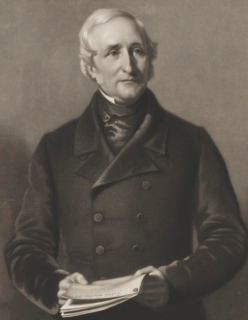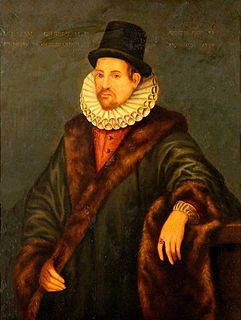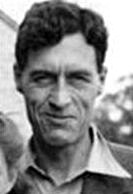Related Research Articles

Sir Joseph John Thomson was a British physicist and Nobel Laureate in Physics, credited with the discovery of the electron, the first subatomic particle to be discovered.

Sir Edward Sabine was an Irish astronomer, geophysicist, ornithologist, explorer, soldier and the 30th president of the Royal Society.

William Gilbert, also known as Gilberd, was an English physician, physicist and natural philosopher. He passionately rejected both the prevailing Aristotelian philosophy and the Scholastic method of university teaching. He is remembered today largely for his book De Magnete (1600).
In theoretical physics, particularly in discussions of gravitation theories, Mach's principle is the name given by Einstein to an imprecise hypothesis often credited to the physicist and philosopher Ernst Mach. The purpose of the hypothesis was to attempt to explain how rotating objects maintain a frame of reference, such as gyroscopes and spinning celestial bodies. The idea is that the existence of absolute rotation is determined by the large-scale distribution of matter, as exemplified by this anecdote:
You are standing in a field looking at the stars. Your arms are resting freely at your side, and you see that the distant stars are not moving. Now start spinning. The stars are whirling around you and your arms are pulled away from your body. Why should your arms be pulled away when the stars are whirling? Why should they be dangling freely when the stars don't move?

Pieter Zeeman was a Dutch physicist who shared the 1902 Nobel Prize in Physics with Hendrik Lorentz for his discovery of the Zeeman effect.

In physics, the dynamo theory proposes a mechanism by which a celestial body such as Earth or a star generates a magnetic field. The dynamo theory describes the process through which a rotating, convecting, and electrically conducting fluid can maintain a magnetic field over astronomical time scales. A dynamo is thought to be the source of the Earth's magnetic field and the magnetic fields of Mercury and the Jovian planets.

Patrick Maynard Stuart Blackett, Baron Blackett was a British experimental physicist known for his work on cloud chambers, cosmic rays, and paleomagnetism, winning the Nobel Prize for Physics in 1948. In 1925 he became the first person to prove that radioactivity could cause the nuclear transmutation of one chemical element to another. He also made a major contribution in World War II advising on military strategy and developing operational research. His left-wing views saw an outlet in third world development and in influencing policy in the Labour Government of the 1960s.
Anti-gravity is a hypothetical phenomenon of creating a place or object that is free from the force of gravity. It does not refer to the lack of weight under gravity experienced in free fall or orbit, or to balancing the force of gravity with some other force, such as electromagnetism or aerodynamic lift. Anti-gravity is a recurring concept in science fiction, particularly in the context of spacecraft propulsion. Examples are the gravity blocking substance "Cavorite" in H. G. Wells's The First Men in the Moon and the Spindizzy machines in James Blish's Cities in Flight.
Experimental physics is the category of disciplines and sub-disciplines in the field of physics that are concerned with the observation of physical phenomena and experiments. Methods vary from discipline to discipline, from simple experiments and observations, such as the Cavendish experiment, to more complicated ones, such as the Large Hadron Collider.

In the theory of general relativity, the equivalence principle is the equivalence of gravitational and inertial mass, and Albert Einstein's observation that the gravitational "force" as experienced locally while standing on a massive body is the same as the pseudo-force experienced by an observer in a non-inertial (accelerated) frame of reference.
The timeline of luminiferous aether or ether as a medium for propagating electromagnetic radiation begins in the 18th century. The aether was assumed to exist for much of the 19th century—until the Michelson–Morley experiment returned its famous null result. Further experiments were in general agreement with Michelson and Morley's result. By the 1920s, most scientists rejected the aether's existence.
The Dillon-Wagoner Graviton Polarity Generator, known colloquially as the spindizzy, is a fictitious anti-gravity device imagined by James Blish for his series Cities in Flight. This device grows more efficient with the amount of mass being lifted, which was used as the hook for the stories—it was more effective to lift an entire city than it was to lift something smaller, such as a classic spaceship. This is taken to extremes in the final stories, where an entire planet is used to cross the galaxy in a matter of hours using the spindizzy drive.
In physics, aether theories propose the existence of a medium, a space-filling substance or field as a transmission medium for the propagation of electromagnetic or gravitational forces. Since the development of special relativity, theories using a substantial aether fell out of use in modern physics, and are now replaced by more abstract models.
This timeline lists significant discoveries in physics and the laws of nature, including experimental discoveries, theoretical proposals that were confirmed experimentally, and theories that have significantly influenced current thinking in modern physics. Such discoveries are often a multi-step, multi-person process. Multiple discovery sometimes occurs when multiple research groups discover the same phenomenon at about the same time, and scientific priority is often disputed. The listings below include some of the most significant people and ideas by date of publication or experiment.

The history of electromagnetic theory begins with ancient measures to understand atmospheric electricity, in particular lightning. People then had little understanding of electricity, and were unable to explain the phenomena. Scientific understanding into the nature of electricity grew throughout the eighteenth and nineteenth centuries through the work of researchers such as Coulomb, Ampère, Faraday and Maxwell.

Hans Christian Ørsted was a Danish physicist and chemist who discovered that electric currents create magnetic fields, which was the first connection found between electricity and magnetism. Oersted's law and the oersted (Oe) are named after him.

Archibald Smith of Jordanhill was a Scots-born barrister and amateur mathematician.

Gravitoelectromagnetism, abbreviated GEM, refers to a set of formal analogies between the equations for electromagnetism and relativistic gravitation; specifically: between Maxwell's field equations and an approximation, valid under certain conditions, to the Einstein field equations for general relativity. Gravitomagnetism is a widely used term referring specifically to the kinetic effects of gravity, in analogy to the magnetic effects of moving electric charge. The most common version of GEM is valid only far from isolated sources, and for slowly moving test particles.

The history of geomagnetism is concerned with the history of the study of Earth's magnetic field. It encompasses the history of navigation using compasses, studies of the prehistoric magnetic field, and applications to plate tectonics.
Evan James Williams FRS was a Welsh experimental physicist who worked in a number of fields with some of the most notable physicists of his day, including Patrick Blackett, Lawrence Bragg, Ernest Rutherford and Niels Bohr.
References
- ↑ A Critical Examination of the Possible Causes of Terrestrial Magnetism, A. Schuster, Proceedings of the Physical Society of London24 (1911–1912), pp. 121–137.
- ↑ An Experiment on the Origin of the Earth's Magnetic Field, H. A. Wilson, Proceedings of the Royal Society of London, Series A104, #727 (November 1, 1923), pp. 451–455.
- ↑ The magnetic field of massive rotating bodies, P. M. S. Blackett, Nature159, #4046 (May 17, 1947), pp. 658–666.
- ↑ Patrick Maynard Stuart Blackett, Baron Blackett, of Chelsea, 18 November 1897-13 July 1974, Bernard Lovell, Biographical Memoirs of Fellows of the Royal Society21 (November 1975), pp. 1–115.
- ↑ Cities in Flight, James Blish. New York: Avon, 1982. ISBN 0-380-00998-6.